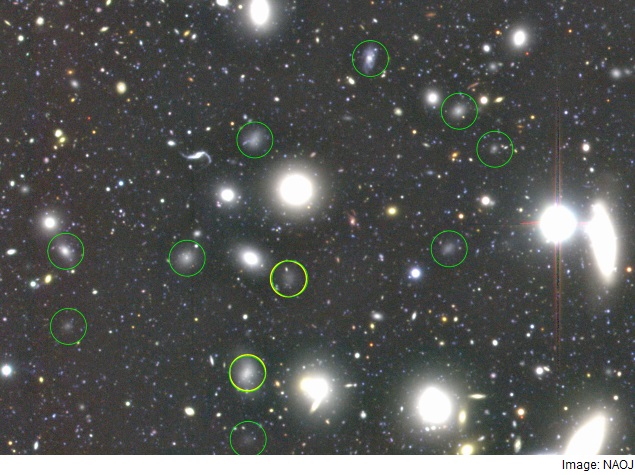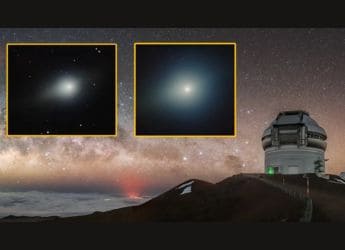- Home
- Science
- Science News
- Over 800 'Dark Galaxies' Found in Coma Cluster
Over 800 'Dark Galaxies' Found in Coma Cluster

The discovery surpasses the last year's discovery of 47 mysterious dark galaxies by more than 800 and suggests that galaxy clusters are the key environment for the evolution of such galaxies.
"The finding suggests that these galaxies appear very diffuse and are very likely enveloped by something very massive," said Jin Koda, principal investigator of the study and Associate Professor in the Department of Physics and Astronomy at Stony Brook University in New York, US.
The ultra-dark galaxies are similar in size to the Milky Way, but have only 1/1,000 of stars that our galaxy does.
The stellar population within such fluffy extended galaxies is subject to rapid disruption due to a strong tidal force detected within the cluster.
"We believe that something invisible must be protecting the fragile star systems of these galaxies, something with a high mass," said Koda.
"That 'something' is very likely an excessive amount of dark matter," Koda said. The component of visible matter, such as stars, is calculated to contribute only one percent or less to the total mass of each galaxy. The rest - dark matter - accounts for more than 99 percent.
The Subaru Telescope, located at the Mauna Kea Observatory on Hawaii, showed that these dark galaxies contain old stellar populations and shows a spatial distribution similar to those of other brighter galaxies in the Coma Cluster.
It suggests that there has been a long-lived population of galaxies within the cluster and the amount of visible matter they contain, less than one percent, is extremely low compared to the average fraction within the universe.
These galaxies are dark because they have lost gas needed to create new stars during, or after, their largely unknown formation process billions of years ago. From their preferential presence within the cluster, it's likely that the cluster environment played a key role in the loss of gas, which affects star formation within the galaxy.
Several loss mechanisms are possible, including ram-pressure stripping by intra-cluster gas, gravitational interactions with other galaxies within the cluster, and gas outflows due to simultaneous supernova explosions triggered by the ram pressure or gravitational encounters.
The Coma Cluster is a large cluster of galaxies that contains over 1,000 identified galaxies. Along with the Leo Cluster, it is one of the two major clusters comprising the Coma Supercluster.
Dark matter is a hypothetical kind of matter that cannot be seen with telescopes but would account for most of the matter in the universe.
The finding was published in the Astrophysical Journal Letters.
Get your daily dose of tech news, reviews, and insights, in under 80 characters on Gadgets 360 Turbo. Connect with fellow tech lovers on our Forum. Follow us on X, Facebook, WhatsApp, Threads and Google News for instant updates. Catch all the action on our YouTube channel.
Related Stories
- Samsung Galaxy Unpacked 2025
- ChatGPT
- Redmi Note 14 Pro+
- iPhone 16
- Apple Vision Pro
- Oneplus 12
- OnePlus Nord CE 3 Lite 5G
- iPhone 13
- Xiaomi 14 Pro
- Oppo Find N3
- Tecno Spark Go (2023)
- Realme V30
- Best Phones Under 25000
- Samsung Galaxy S24 Series
- Cryptocurrency
- iQoo 12
- Samsung Galaxy S24 Ultra
- Giottus
- Samsung Galaxy Z Flip 5
- Apple 'Scary Fast'
- Housefull 5
- GoPro Hero 12 Black Review
- Invincible Season 2
- JioGlass
- HD Ready TV
- Laptop Under 50000
- Smartwatch Under 10000
- Latest Mobile Phones
- Compare Phones
- Redmi Note 15 5G
- Redmi Note 15 Pro 5G
- Redmi Note 15 Pro+ 5G
- Lava Play Max
- Poco C85 5G
- Honor Magic 8 Lite
- Jolla Phone
- Realme P4x 5G
- Asus ProArt P16
- MacBook Pro 14-inch (M5, 2025)
- OnePlus Pad Go 2
- Poco Pad M1
- Just Corseca Skywatch Pro
- Honor Watch X5
- Acerpure Nitro Z Series 100-inch QLED TV
- Samsung 43 Inch LED Ultra HD (4K) Smart TV (UA43UE81AFULXL)
- Asus ROG Ally
- Nintendo Switch Lite
- Haier 1.6 Ton 5 Star Inverter Split AC (HSU19G-MZAID5BN-INV)
- Haier 1.6 Ton 5 Star Inverter Split AC (HSU19G-MZAIM5BN-INV)
-
 Early Earth’s Deep Mantle May Have Held More Water Than Previously Believed, Study Finds
Early Earth’s Deep Mantle May Have Held More Water Than Previously Believed, Study Finds
-
 Nandamuri Balakrishna's Akhanda 2 Arrives on OTT in 2026: When, Where to Watch the Film Online?
Nandamuri Balakrishna's Akhanda 2 Arrives on OTT in 2026: When, Where to Watch the Film Online?
-
 Single Papa Now Streaming on OTT: All the Details About Kunal Khemu’s New Comedy Drama Series
Single Papa Now Streaming on OTT: All the Details About Kunal Khemu’s New Comedy Drama Series
-
 Scientists Study Ancient Interstellar Comet 3I/ATLAS, Seeking Clues to Early Star System Formation
Scientists Study Ancient Interstellar Comet 3I/ATLAS, Seeking Clues to Early Star System Formation











